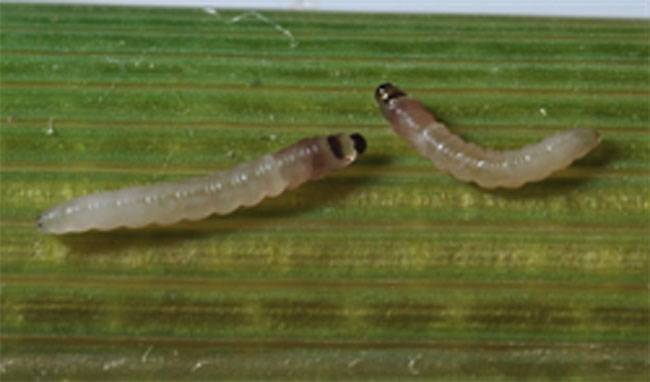Paddy
Yellow Stem Borer

Yellow Stem Borer
Scirpophaga incertulas

Yellow Stem Borer
Scirpophaga incertulas
Rice stem borers are among the most destructive pests of rice, capable of causing significant yield losses if not managed effectively. This blog provides an overview of the stem borers, their impact, identification, and management strategies.
Key Species of Rice Stem Borers
Six species of stem borers attack rice crops, each with unique characteristics:
Yellow Stem Borer (Scirpophaga incertulas): A major pest in tropical wetland and deep-water rice, it thrives in continuously flooded areas.
White Stem Borer: A critical pest in rainfed wetland rice.
Striped Stem Borer: Common in temperate countries and non-flooded areas; it can cause up to 100% damage when severe.
Gold-Fringed Stem Borer: Can lead to yield losses of about 30%.
Dark-Headed Striped Stem Borer: Another significant pest in rice cultivation.
Pink Stem Borer: Less important in rice but prefers sugarcane as its primary host. It is commonly found in upland rice near sugarcane fields.
What Stem Borers Do
Stem borers attack rice plants from the seedling to maturity stages. Their feeding behavior leads to:
Deadhearts: Drying of the central tiller during the vegetative stage.
Whiteheads: Empty or unfilled panicles at the reproductive stage.
Why and Where They Occur
Larval Behavior: Larvae bore at the base of the plant in the vegetative stage and through the upper nodes in older plants.
Species-Specific Habitats:
Yellow stem borer thrives in continuously flooded environments.
Striped stem borer is abundant in non-flooded, temperate regions.
Pink stem borer is found in upland rice near sugarcane fields.
Favorable Conditions: High nitrogen levels, late planting, and leftover stubble in fields promote their population buildup.
Identifying Stem Borer Damage
Look for the following symptoms:
Deadhearts: Dead tillers that can be easily pulled from the base during vegetative stages.
Whiteheads: Whitish, empty panicles during reproductive stages.
Holes and Frass: Tiny holes on stems and tillers with frass inside.
Confirmation: Dissect stems to find larvae or pupae.
Impact of Stem Borer Damage
Yield Losses:
Yellow stem borer: Up to 80% in late-planted crops.
White stem borer: Can cause field-wide destruction.
Striped stem borer: Damage can reach 100% under severe infestation.
Gold-fringed stem borer: Yield losses of around 30%.
Management Strategies
Cultural Practices:
Use resistant rice varieties.
Handpick and destroy egg masses.
Submerge eggs by raising irrigation water periodically.
Cut leaf tops before transplanting to reduce egg carry-over.
Synchronize planting and harvest crops at ground level to remove larvae in stubble.
Remove stubble, volunteer rice, and flood fields after plowing.
Biological Control:
Encourage natural predators and parasites such as:
Wasps (e.g., braconid, eulophid, trichogrammatid).
Beetles (e.g., ladybird beetles).
Flies (e.g., chloropid, asilid).
Spiders and dragonflies.
Employ bacterial and fungal pathogens to infect larvae.
Nutrient Management:
Apply nitrogen fertilizers in split doses, following recommended rates and timings.
Monitoring and Forewarning:
Track temperature and humidity conditions conducive to outbreaks:
Mean temperature below 28°C with continuous rainfall favors infestation.
Issue warnings based on weather patterns.
Lifecycle and Development of the Yellow Stem Borer
Eggs: Laid on the upper surface of leaves in groups (average 80), covered with tan scales.
Larvae: White larvae bore into leaf sheaths, causing yellowish-white patches and later deadhearts or whiteheads. Fully grown larvae are pale-yellow to greenish and about 20 mm long.
Pupation: Occurs in white silk cocoons inside hollow stems near the base of the plant.
Dormancy: Larvae survive in stubble during dry periods or rice-free seasons.
Spread of Infestation
Short-distance spread occurs via eggs on infested seedlings, larvae crawling or dispersing on silken threads, pupae in harvested stems, and adults flying at night.
Long-distance spread is facilitated by farm machinery and crop residues.
By understanding the biology and behavior of rice stem borers, implementing integrated pest management practices, and monitoring environmental conditions, rice farmers can significantly reduce the impact of these destructive pests and ensure sustainable crop production.
ImageCredits: Plantvillage
